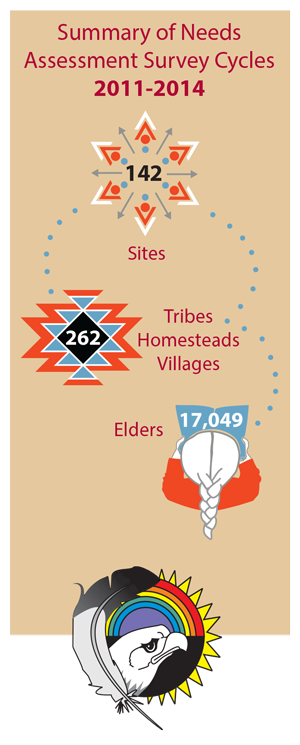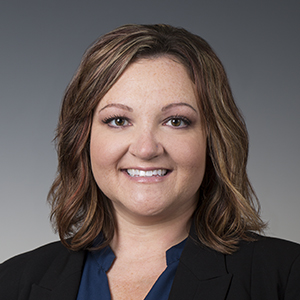NRCNAA Celebrates 20 Years Helping Native Elders
The National Resource Center on Native American Aging (NRCNAA) is celebrating its 20th Anniversary.
By Nikki Massmann on

The program, which is located in the Center for Rural Health, began in 1994 through a cooperative agreement with the Administration on Aging (now known as the Administration on Community Living) in the U.S. Department of Health and Human Services. Native American elders have many of the same needs as other elder populations, and the idea behind the program was to be able to provide a way to identify specific needs within communities. The NRCNAA accomplishes this through their needs assessment survey, "Identifying Our Needs: A Survey of Elders."
The surveys run on three-year cycles. Each tribe that wants to participate first passes a tribal resolution so that the information gathered is theirs to use. The tribes themselves have ownership of the data, and NRCNAA staff process it for them. Each participating tribe is provided with one-on-one training in how to collect information for the surveys, and how to use the data that are gathered. The NRCNAA just completed Cycle 5 of the surveys (2011–2014) with 262 tribes, villages, or homesteads participating across the nation.
"On reservations, the approach for surveys isn't to send someone from our office to each of these participating areas and go door to door," said Patty Stensland, research specialist for the NRCNAA. "We make a connection with someone from their own community, and teach them about the survey and gathering information."
It's a visit from a friend.
Adds Paula Carter, PhD, program director, "For the elders, the survey isn't just a researcher calling. It's a visit from a friend. They might share a meal or a cup of coffee. It's important to have that connection; it helps build a relationship and earns trust in our program from the participants—our cherished elders."
Once the NRCNAA receives survey results from a tribe, the turnaround in analyzing the data happens within a day or two. Results, including comparisons to the previous cycles and national trends among other tribes, are sent directly to the tribal council. "It's important to be responsive to our participants," Stensland said. "They trust us to provide them with the information to ensure that much-needed services continue in their communities."
Information derived from the surveys is used in a variety of ways. First and foremost, the results and technical assistance provided to the tribes help empower Native people to develop community-based solutions in addressing the needs identified. Additionally, the information helps determine funding for Title VI programs, which provide nutrition programs for Native American elders. Survey results can also be used to apply for grants and determine what types of programs would be the most beneficial for that specific tribe or reservation. They also highlight health disparities that exist on reservations.
"Through knowing where the areas of greatest need are, we can help find resources to help make changes toward better health and care of our elders," Carter said. "Services to address needs are oftentimes inaccessible in Native American communities. The NRCNAA works to provide high-quality services while maintaining cultural values. This can enhance the elders' self-perception, worth, and dignity—leading to overall well-being."
For Stensland, analyzing the data for tribes is personal. She began with the NRCNAA in 1995, and was trained on collecting the surveys in her home community on the Spirit Lake Reservation in North Dakota. She collected data for the survey cycles and became the face that everyone knew would come to visit and ask questions.
 "Numbers and data can sound uninteresting
and honestly intimidating for a reservation community,"
Stensland said. "It is so critical that the person
collecting the information from the elders is someone
they know. Sometimes there aren't addresses on a
reservation, so you have to know who lives where and how
to find them for a visit. Once you get them interested in
what you are doing with the numbers, it begins to paint a
picture for them. I would often get told by an elder that
they knew my visit meant the continuation of a meal
program in their community."
"Numbers and data can sound uninteresting
and honestly intimidating for a reservation community,"
Stensland said. "It is so critical that the person
collecting the information from the elders is someone
they know. Sometimes there aren't addresses on a
reservation, so you have to know who lives where and how
to find them for a visit. Once you get them interested in
what you are doing with the numbers, it begins to paint a
picture for them. I would often get told by an elder that
they knew my visit meant the continuation of a meal
program in their community."
Now that Stensland is providing the training on collecting survey information, it has come full circle for her. "I love being able to connect with tribes across the nation," she said. "I had some great mentors through the NRCNAA that really allowed me to see the benefit of helping tribes collect their own data."
That data has led to the development of several resources available through the NRCNAA. The Service Locator is an interactive map on their website that lists all tribal elderly services available in the United States. In addition to the Service Locator, the NRCNAA provides a program called WELL-Balanced.
WELL-Balanced stands for Wise Elders Living Longer. The program was developed specifically for Native American elders. It combines exercise, information, and social interaction to help elders remain active and independent in their own homes as long as possible. The program is available free of charge to any organization serving the Native American elder community.
"The focus areas of WELL-Balanced were derived from the surveys," Carter said. "But the key piece to the program is having fun while participating!"
The NRCNAA has many accomplishments of which to be proud. Through strong leadership and trustworthy connections with tribes, the program aims to be around for another twenty years.
For more information about the NRCNAA, visit https://www.nrcnaa.org.
This article originally appeared in the Holiday 2014 issue of North Dakota Medicine.


 is the Director of Communications at the Energy and Environmental Research Center (EERC). Prior to her position at the EERC, she served as Communication Coordinator at the Center for Rural Health at the University of North Dakota's School of Medicine & Health Sciences.
is the Director of Communications at the Energy and Environmental Research Center (EERC). Prior to her position at the EERC, she served as Communication Coordinator at the Center for Rural Health at the University of North Dakota's School of Medicine & Health Sciences.



